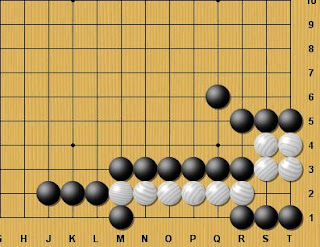..I wanted to post this for a long time now, today I'll finally do it.
In a discussion with John and Flavien about a Joseki I remembered a move my teacher in Berlin played once. I showed it to them but even though we invested quite some time in checking all the variations we could not come up with a definite solution. Anyway I did continue our research using Moyo Go, finding four games in which our move was actually played.
Still it was impossible for me to understand
why the pros did play the way they did. Thats when I decided to just go and ask them. The following diagrams are therefore not only based on the discussion with John but also on the opinion of three professionals.
Dia 1: The basic Joseki.
The moves up to 13 are common knowledge, 14 is one possible way to continue. Normally the ladder should be good for White otherwise the cut at A becomes a big problem. Regardless of this Black will probably cut at A next -
Dia 2: The cotinuation
The sequence up to 29 is a joseki. Note that White can't pull out his stones without a favorable ladder after the sequence of White A, Black B, White C, Black D.
Even though the moves here form an established Joseki there are some interesting variations -
Dia 3: The Kagetsugi
For example Withe could choose to kagetsugi with 6 in this diagram. I remembered my teacher playing this move putting me into big trouble.
Naturally black has to defend his stones at the top -
Dia 4: Pro Game
He can do this with 2-14 in the dia to the right.
This sequence is taken from a game between Sakata Eio and Kataoka Satoshi and we could call this result about even.
However the question comes up if it is really nececcary for Black to crawl on the second line up to 10 or if he can capture the corner stones before.
Dia 5: Capturing the corner stones
Indeed all the professionals confirmed that it is possible for Black to capture the white stones without having to spend an additional move on the second line.
Note that 3 is the Tesuji in this position. 6 and 8 are about the best that White can do but still he is losing the semiai by one move after 13.
Even though this is possible it did not happen in any of the games I found using Moyo Go.
According to one of the pros I asked about this it is because Black has to take all the White stones of the board which means that his capture will be not as big as it seems. Moreover Black will end in Gote.
The point of Dia 4 is that after 10 Black would already be locally alive if White used 11 to continue to push at the top, for this reason Black would not have to add any moves in the corner giving him a superior result. Thats why White plays 11 in the corner, saving his group there.
Dia 6: Testing the new move in an actual game
After all those studies I felt like testing the new move in an actual Insei-game.
Obviously my opponent didn't know about this variation and so he spent a lot of time here, finally coming up with the mistake of 27. Anyway I was so happy to capture the four black stones on the left that I did not think before playing the atari of 30, which is one of the reasons why I lost this game. In fact it would be good for Withe to just play 30 at 32 for the ladder is good for White. In this case Black could not do much but playing a ladder break which White would ignore to secure his capture in the upper left corner. If White did play 30 at 32 the game would be clearly favourable for him. Anyway after the bad exchange of 30 for 31 Black set up a perfect sacrifice with 33 and 35, enabling Black to close White of in Sente, giving him tremendous outside thickness. (Note that the three white stones are lacking liberties so Black can force White to capture the four black stones at any time.)
Even though this game was a failure I think I will try the Kagetsugi again in the future.
I hope we can study together then once again.








































